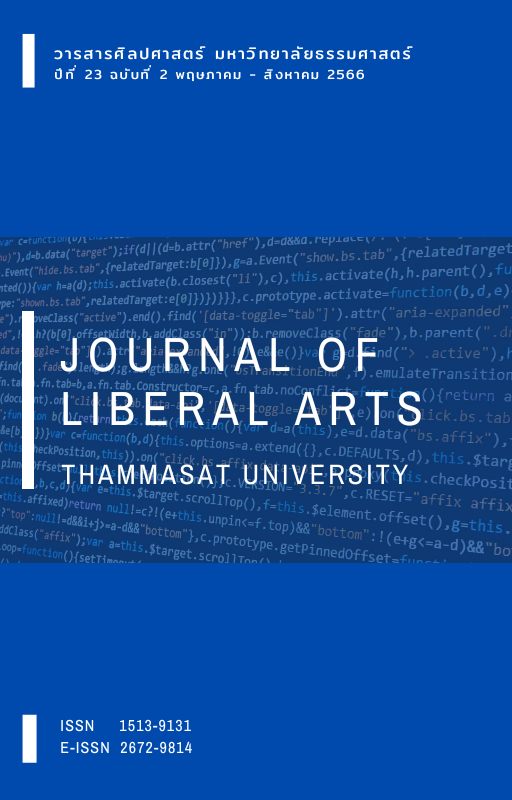Students’ Expectations and Satisfaction toward being taught Japanese Listening-Speaking by a Thai Teacher
Main Article Content
Abstract
This study examines students’ expectations of and satisfaction with a Japanese listening-speaking course taught by a Thai teacher. The research participants were 26 freshman Japanese major students. The analysis showed two major findings. First, regarding the students’ expectations toward the teacher’s language use, 73% of students expected the teacher to use Japanese language as the main medium of teaching, and 27% of students expected the teacher to use both Japanese and Thai. The top three expectations for classroom activities were: (1) listening comprehension, (2) conversation practice with friends, and (3) pronunciation practice. Second, regarding students’ satisfaction, the results showed that they were satisfied with a Japanese listening-speaking class taught by a Thai teacher at a high level. The top three of students’ most satisfying classroom activities were: (1) 3-minute speech, (2) playing games, and (3) writing a reflection paper. Most of the students thought that the classroom atmosphere was relaxed and friendly. The classroom activities were diverse, enjoyable, and encouraging for their learning motivation.
Downloads
Article Details

This work is licensed under a Creative Commons Attribution-NonCommercial-NoDerivatives 4.0 International License.
References
คุณัชญ์ สมชนะกิจ, พจนา เดชสถิต, ทาคายูกิ คากิซากิ, และ ชวเลิศ เทพประดิษฐ์. (2560). สภาพปัญหาและการปรับตัวของผู้สอนภาษาญี่ปุ่นระดับอุดมศึกษาในจังหวัดชายแดนใต้. วารสารมนุษยศาสตร์สังคมศาสตร์ มหาวิทยาลัยทักษิณ, 12(1), 181-205.
บุญชม ศรีสะอาด. (2539). การแปลผลเมื่อใช้เครื่องมือรวบรวมข้อมูลแบบมาตราส่วนประมาณค่า. วารสารการวัดผลการศึกษามหาวิทยาลัยมหาสารคาม, 2(1), 64-70.
พรเทพ คัชมาตย์. (2560). การศึกษาทัศนคติของนักศึกษาสาขาวิชาภาษาอังกฤษที่มีต่อความหลากหลายทางภาษาอังกฤษของโลก อาจารย์สอนภาษาอังกฤษที่ไม่ใช่เจ้าของภาษา และอาจารย์เจ้าของภาษา: กรณีศึกษามหาวิทยาลัยราชภัฏเทพสตรี. ใน มหาวิทยาลัย ราชภัฏพิบูลสงคราม, รายงานสืบเนื่องการประชุมสัมมนาวิชาการ (Proceedings) การนำเสนอผลงานวิจัยระดับชาติ เครือข่ายบัณฑิตศึกษา มหาวิทยาลัยราชภัฏภาคเหนือ ครั้งที่ 17 (น. 1225-1238). มหาวิทยาลัยราชภัฏพิบูลสงคราม.
ภรณีย์ พินันโสตติกุล และ Yumiko Yamamoto. (2562). ทัศนคติของผู้เรียนต่อการจัดการเรียนการสอนร่วมระหว่างผู้สอนชาวไทยและชาวญี่ปุ่น. วารสารเครือข่ายญี่ปุ่นศึกษา, 9(2), 26-40.
ยุพกา ฟูกุชิม่า. (2562). ทัศนคติของผู้เรียนต่อการบรรยายด้วยภาษาญี่ปุ่นของผู้สอนชาวไทยในรายวิชาการอ่านภาษาญี่ปุ่นขั้นสูง. วารสารเครือข่ายญี่ปุ่นศึกษา, 9(1), 25-48.
ยุพกา ฟูกุชิม่า และ ริกะ อินะงะขิ. (2562). ความเชื่อ และความคาดหวังของผู้เรียนภาษาญี่ปุ่นชาวไทยต่อชั้นเรียนภาษาญี่ปุ่น ครูภาษาญี่ปุ่น และบทบาทของผู้สอน. วารสารเครือข่ายญี่ปุ่นศึกษา, 9(2), 1-25.
ศฬิษา วิทยาศรัย และ สมบูรณ์ พจน์ประสาท. (2019). การเปรียบเทียบความคิดเห็นและผลสัมฤทธิ์ทางภาษาอังกฤษของนักศึกษาที่เรียนกับอาจารย์เจ้าของภาษาและอาจารย์ชาวไทย. Veridian E-Journal, Silpakorn University (Humanities, Social Sciences and arts), 12(6), 103-121.
อัษฎายุทธ ชูศรี. (2012). การใช้ภาษาญี่ปุ่นในการบรรยายโดยผู้สอนชาวไทย กรณีศึกษาการสอนวิชาเนื้อหาระดับกลางสูงในจุฬาลงกรณ์มหาวิทยาลัย. วารสารเจแปนฟาวน์เดชั่น กรุงเทพฯ, 9, 139-144.
เอื้อมพร หลินเจริญ. (2555). เทคนิคการวิเคราะห์ข้อมูลเชิงคุณภาพ. วารสารการวัดผลการศึกษา, 17(1), 17-29.
Abe, Y., & Yokoyama, N. (1991). Kaigai nihongokyooshi chookikenshuu no kadai: Gaikokujin nihongokyooshi no riten o ikashita kyoojuhoo o motomete. Nihongo Kokusai Center Kiyoo, 1, 53-74.
Boonserm, S. (2012). Japanese language learners’ perception toward “classroom activities” in case of Thailand university students: In perspective of “preference” “enjoyment” and “effectiveness”. Japanese Language Education Methods, 19(2), 44-45. (in Japanese)
Cardozo, R. (1965). An experimental study of customer effort, expectation and satisfaction. Journal of Marketing Research, 2(3), 244–249.
Kaiser, S. (1995). The role of the non-native teacher in the teaching of Japanese: Towards the language classroom as a venue for intercultural education. Journal of Japanese Language Teaching, 10, 95-106.
Kongjit, S., & Yoshida, N. (2012). Team Teaching ni okeru neetibu kyooshi to non-neetibu kyooshi no yakuwari buntan: Chiangmai daigaku shokyuu nihongo kurasu no taijin gakushuusha no kitai. Japanese Language Education Bulletin Japan Foundation Bangkok, 9, 129-138. (in Japanese)
Laohaburanakit Katagiri, K., Iketani, K., Katagiri, J., & Nakayama, E. (2009, November). Experiences and Hon’ne of Thai teachers on collaboration with Japanese teachers in Japanese language education: With a special reference to the ‘Accuracy-Focus’ views of teaching [Paper presentation]. In Institute of Teacher Education Malaysia, The 21st Century Approach to Japanese Studies Programmes Towards the Creation of a New Academic Network between Japan and Southeast Asia, Kuala Lumpur, Malaysia.
Nagasaka, M., & Kida, M. (2011). Chuugoku no daigaku no nihongojugyoo ni okeru kaiwashidoo ni kansuru choosa: Chuu-Jookyuu reberu o taishoo to shita kyooshitsukatsudoo no jittai to kyooshi no ishiki. The Japan Foundation Japanese-Language Education Bulletin, 7, 43-57. (in Japanese)
Okamoto, K. (2010). “Native” and “non-native” teachers’ beliefs and their teaching practice in a team teaching situation. Handai nihongo kenkyuu, 22, 205-235. (in Japanese)
Sallivan, C. (2016). Student Preferences and Expectations in English Classroom. Gengobunka, 52, 35-47.
Sasajima, S., & Borg, S. (2009). Gengo kyooshi ninchi no kenkyuu. Kaitakusha.
Shin, J. E. (2006). Nihon kokunai no hibogowasha nihongo kyooshi ni taisuru gakushuusha no henyoo: Waseda daigaku no shokyuu jissen o tooshite. Kooza Nihongo Kyooiku, 42, 60-81. (in Japanese)
Takahashi, M. (2015). View of Japanese-language education in Japan by non-native teachers: Proposal for diversification of language teachers in multicultural symbiotic societies. Journal for the Study of Japanese Language Education Practice, 2, 104-113. (in Japanese)
Takahashi, M. (2019). An overview of the cognition of non-native language teachers: Do they share their native languages and cultural backgrounds with students?. Showajoshi daigaku daigakuin gengokyooiku komyunikeeshon kenkyuu, 13, 1-17.
Yokota, T. (2013). A Survey of foreign students’ view towards Non-native Japanese language teachers in Japan. In University of Toronto, 2013 CAJLE Annual Conference Proceedings (pp. 322-331). https://www.cajle.ca/conference-proceedings/cajle2013-proceedings/ (in Japanese)
Yen, H.-Y. (2003a). Opinions on Teacher's Use of the Mother Tongue in Japanese Conversation Classes in Universities in Taiwan: Based on the opinion poll among teachers and learners in different semesters. Bulletin of the Department of Teaching Japanese as a Second Language, Hiroshima University, 13, 59-66. (in Japanese)
Yen, H.-Y. (2003b). Opinions on Teacher's Use of the Mother Tongue in Japanese Conversation Classes: from the result of questionnaire research at seven universities in Taiwan. The bulletin of Japanese Curriculum Research and Development, 25(4), 59-68. (in Japanese)
Wu, Y.-C., Hsieh, L.-F., & Lu, J.-J. (2015). What’s The Relationship Between Learning Satisfaction and Continuing Learning Intention?. Procedia–Social and Behavioral Science, 191, 2849-2854.

